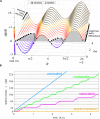Coordination Dynamics: A Foundation for Understanding Social Behavior
- PMID: 32922277
- PMCID: PMC7457017
- DOI: 10.3389/fnhum.2020.00317
Coordination Dynamics: A Foundation for Understanding Social Behavior
Abstract
Humans' interactions with each other or with socially competent machines exhibit lawful coordination patterns at multiple levels of description. According to Coordination Dynamics, such laws specify the flow of coordination states produced by functional synergies of elements (e.g., cells, body parts, brain areas, people…) that are temporarily organized as single, coherent units. These coordinative structures or synergies may be mathematically characterized as informationally coupled self-organizing dynamical systems (Coordination Dynamics). In this paper, we start from a simple foundation, an elemental model system for social interactions, whose behavior has been captured in the Haken-Kelso-Bunz (HKB) model. We follow a tried and tested scientific method that tightly interweaves experimental neurobehavioral studies and mathematical models. We use this method to further develop a body of empirical research that advances the theory toward more generalized forms. In concordance with this interdisciplinary spirit, the present paper is written both as an overview of relevant advances and as an introduction to its mathematical underpinnings. We demonstrate HKB's evolution in the context of social coordination along several directions, with its applicability growing to increasingly complex scenarios. In particular, we show that accommodating for symmetry breaking in intrinsic dynamics and coupling, multiscale generalization and adaptation are principal evolutions. We conclude that a general framework for social coordination dynamics is on the horizon, in which models support experiments with hypothesis generation and mechanistic insights.
Keywords: Coordination Dynamics; HMI; HRI; Human Dynamic Clamp; complex systems; metastability; multiscale; social interaction.
Copyright © 2020 Tognoli, Zhang, Fuchs, Beetle and Kelso.
Figures




Similar articles
-
Third party stabilization of unstable coordination in systems of coupled oscillators.J Phys Conf Ser. 2021;2090:012167. doi: 10.1088/1742-6596/2090/1/012167. Epub 2021 Dec 2. J Phys Conf Ser. 2021. PMID: 37333713 Free PMC article.
-
The Haken-Kelso-Bunz (HKB) model: from matter to movement to mind.Biol Cybern. 2021 Aug;115(4):305-322. doi: 10.1007/s00422-021-00890-w. Biol Cybern. 2021. PMID: 34406513
-
The Development of Bimanual Coordination Across Toddlerhood.Monogr Soc Res Child Dev. 2019 Jun;84(2):7-147. doi: 10.1111/mono.12405. Monogr Soc Res Child Dev. 2019. PMID: 31162687 Free PMC article.
-
Reorganization of the human central nervous system.Gen Physiol Biophys. 2000 Oct;19 Suppl 1:11-240. Gen Physiol Biophys. 2000. PMID: 11252267 Review.
-
Topological portraits of multiscale coordination dynamics.J Neurosci Methods. 2020 Jun 1;339:108672. doi: 10.1016/j.jneumeth.2020.108672. Epub 2020 Mar 6. J Neurosci Methods. 2020. PMID: 32151601 Free PMC article. Review.
Cited by
-
Video-based tracking approach for nonverbal synchrony: A comparison of Motion Energy Analysis and OpenPose.Behav Res Methods. 2021 Dec;53(6):2700-2711. doi: 10.3758/s13428-021-01612-7. Epub 2021 May 23. Behav Res Methods. 2021. PMID: 34027597
-
Unifying Large- and Small-Scale Theories of Coordination.Entropy (Basel). 2021 Apr 27;23(5):537. doi: 10.3390/e23050537. Entropy (Basel). 2021. PMID: 33925736 Free PMC article.
-
Perceptual coupling in human dyads: Kinematics does not affect interpersonal synchronization.Heliyon. 2024 Jun 28;10(13):e33831. doi: 10.1016/j.heliyon.2024.e33831. eCollection 2024 Jul 15. Heliyon. 2024. PMID: 39027589 Free PMC article.
-
Football Match Dynamics Explored by Recurrence Analysis.Front Psychol. 2021 Sep 24;12:747058. doi: 10.3389/fpsyg.2021.747058. eCollection 2021. Front Psychol. 2021. PMID: 34630256 Free PMC article.
-
Third party stabilization of unstable coordination in systems of coupled oscillators.J Phys Conf Ser. 2021;2090:012167. doi: 10.1088/1742-6596/2090/1/012167. Epub 2021 Dec 2. J Phys Conf Ser. 2021. PMID: 37333713 Free PMC article.
References
-
- Anderson P. W. (1972). More is different. Science 177 393–396. - PubMed
Grants and funding
LinkOut - more resources
Full Text Sources

